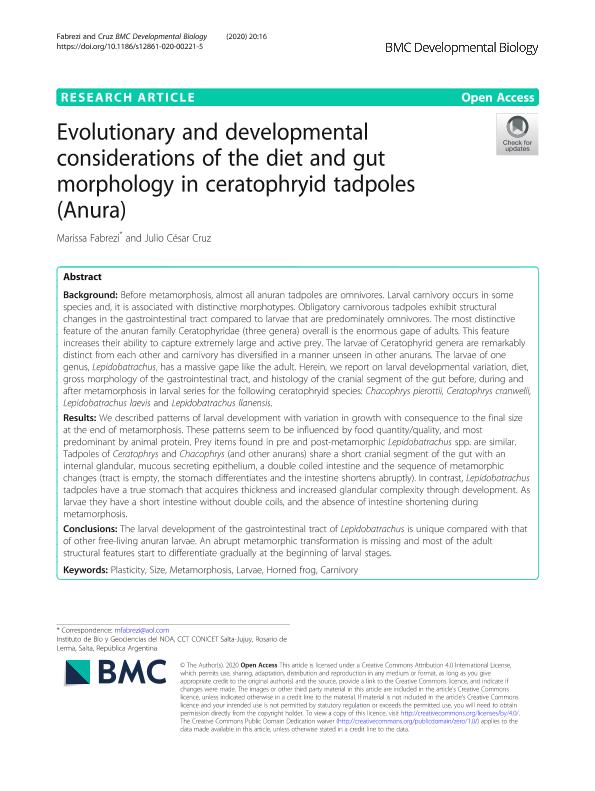Mostrar el registro sencillo del ítem
dc.contributor.author
Fabrezi, Marissa

dc.contributor.author
Cruz, Julio César

dc.date.available
2022-12-27T05:01:29Z
dc.date.issued
2020-07
dc.identifier.citation
Fabrezi, Marissa; Cruz, Julio César; Evolutionary and developmental considerations of the diet and gut morphology in ceratophryid tadpoles (Anura); BioMed Central; BMC Developmental Biology; 20; 1; 7-2020; 1-17
dc.identifier.issn
1471-213X
dc.identifier.uri
http://hdl.handle.net/11336/182395
dc.description.abstract
Background: Before metamorphosis, almost all anuran tadpoles are omnivores. Larval carnivory occurs in some species and, it is associated with distinctive morphotypes. Obligatory carnivorous tadpoles exhibit structural changes in the gastrointestinal tract compared to larvae that are predominately omnivores. The most distinctive feature of the anuran family Ceratophyridae (three genera) overall is the enormous gape of adults. This feature increases their ability to capture extremely large and active prey. The larvae of Ceratophyrid genera are remarkably distinct from each other and carnivory has diversified in a manner unseen in other anurans. The larvae of onegenus, Lepidobatrachus, has a massive gape like the adult. Herein, we report on larval developmental variation, diet, gross morphology of the gastrointestinal tract, and histology of the cranial segment of the gut before, during and after metamorphosis in larval series for the following ceratophryid species: Chacophrys pierottii, Ceratophrys cranwelli, Lepidobatrachus laevis and Lepidobatrachus llanensis. Results: We described patterns of larval development with variation in growth with consequence to the final size at the end of metamorphosis. These patterns seem to be influenced by food quantity/quality, and most predominant by animal protein. Prey items found in pre and post-metamorphic Lepidobatrachus spp. are similar. Tadpoles of Ceratophrys and Chacophrys (and other anurans) share a short cranial segment of the gut with an internal glandular, mucous secreting epithelium, a double coiled intestine and the sequence of metamorphic changes (tract is empty, the stomach differentiates and the intestine shortens abruptly). In contrast, Lepidobatrachus tadpoles have a true stomach that acquires thickness and increased glandular complexity through development. As larvae they have a short intestine without double coils, and the absence of intestine shortening during metamorphosis. Conclusions: The larval development of the gastrointestinal tract of Lepidobatrachus is unique compared with that of other free-living anuran larvae. An abrupt metamorphic transformation is missing and most of the adult structural features start to differentiate gradually at the beginning of larval stages.
dc.format
application/pdf
dc.language.iso
eng
dc.publisher
BioMed Central

dc.rights
info:eu-repo/semantics/openAccess
dc.rights.uri
https://creativecommons.org/licenses/by-nc-sa/2.5/ar/
dc.subject
PLASTICITY
dc.subject
SIZE
dc.subject
METAMORPHOSIS
dc.subject
LARVAE
dc.subject
HORNED FROG
dc.subject
CARNIVORY
dc.subject.classification
Biología del Desarrollo

dc.subject.classification
Ciencias Biológicas

dc.subject.classification
CIENCIAS NATURALES Y EXACTAS

dc.title
Evolutionary and developmental considerations of the diet and gut morphology in ceratophryid tadpoles (Anura)
dc.type
info:eu-repo/semantics/article
dc.type
info:ar-repo/semantics/artículo
dc.type
info:eu-repo/semantics/publishedVersion
dc.date.updated
2021-09-07T13:54:03Z
dc.journal.volume
20
dc.journal.number
1
dc.journal.pagination
1-17
dc.journal.pais
Reino Unido

dc.journal.ciudad
Londres
dc.description.fil
Fil: Fabrezi, Marissa. Consejo Nacional de Investigaciones Científicas y Técnicas. Centro Científico Tecnológico Conicet - Salta-Jujuy. Instituto de Bio y Geociencias del Noroeste Argentino. Universidad Nacional de Salta. Facultad de Ciencias Naturales. Instituto de Bio y Geociencias del Noroeste Argentino; Argentina
dc.description.fil
Fil: Cruz, Julio César. Consejo Nacional de Investigaciones Científicas y Técnicas. Centro Científico Tecnológico Conicet - Salta-Jujuy. Instituto de Bio y Geociencias del Noroeste Argentino. Universidad Nacional de Salta. Facultad de Ciencias Naturales. Instituto de Bio y Geociencias del Noroeste Argentino; Argentina
dc.journal.title
BMC Developmental Biology
dc.relation.alternativeid
info:eu-repo/semantics/altIdentifier/url/https://bmcdevbiol.biomedcentral.com/articles/10.1186/s12861-020-00221-5
dc.relation.alternativeid
info:eu-repo/semantics/altIdentifier/doi/http://dx.doi.org/10.1186/s12861-020-00221-5
Archivos asociados
